Dawn Road Reserve Bushcare’s next 2-hour working bee is on
Sunday, September 11, 2016, from 8am, at the end of McConachie Court.
Please come along and join our happy crew as we do
lots of important work in your neighbourhood.
*** Remember to at least wear long trousers, a long-sleeved shirt,
a broad-brimmed hat and sturdy, closed shoes. ***
Sunscreen, insect repellant, drinking and hand-washing water
as well as light refreshments will be provided.
February 2016:
Catch an audio update on this important revegetation project in this interview with the Dawn Road Reserve Bushcare group’s Janet Mangan.
August

The plant chosen by Dawn Road Reserve Bushcare patron Janet Mangan to define the mowing edge of this regeneration patch is the grassy creek matrush (Lomandra hystrix). Pic: Trina McLellan
There was so much achieved this month and the difference looking at our latest regeneration site is rather satisfying, after the Moreton Bay Regional Council helped move some mulch around the site so it could be spread, with a defined edge, to separate the revegetation site from its adjacent grassy verge.
The mulch – which came from pest species trees that were taken out early this year – will help suppress weed growth and help the shrubs and trees planted over the past few months to grow with less competition and better moisture retention. Over time, the mulch will break down to provide further nutrients to the soil.
The hard work in fact began the afternoon before that latest working bee, when Dawn Road Reserve Bushcare patron Janet Mangan dug almost 100 holes along the edge of the patch for volunteers to plant out with strappy perennials the following morning.
Just inside that sharply defined edge, the Dawn Road Reserve Bushcare volunteers then planted a neat line of creek matrush (Lomandra hystrix), which will easily withstand any overland flooding from the nearby creek.

Volunteers Vanessa and Kerry carefully place the creek matrush (Lomandra hystrix) in the pre-dug holes about 75cm apart, just inside the mowing edge of the new regeneration zone. Pic: Trina McLellan

Volunteer Michael helps drag some of the mulch through to the front of the revegetation patch. Pic: Trina McLellan

As Dawn Road Reserve Bushcare volunteer Kerry gets ready to place one of the lomandras, she primes the planting hole with some pelletised fertiliser to feed the young plant and help it thrive along the edge of the revegetation patch. Pic: Trina McLellan
In the middle of the site, a few more trees and shrubs were added, which will fill out the patch nicely over time and create a decent canopy.

Behind the edge of creek mat rush (Lomandra hystrix), the volunteers planted more shrubs and trees that will grow to fill out the revegetation patch over the coming years. Pic: Trina McLellan
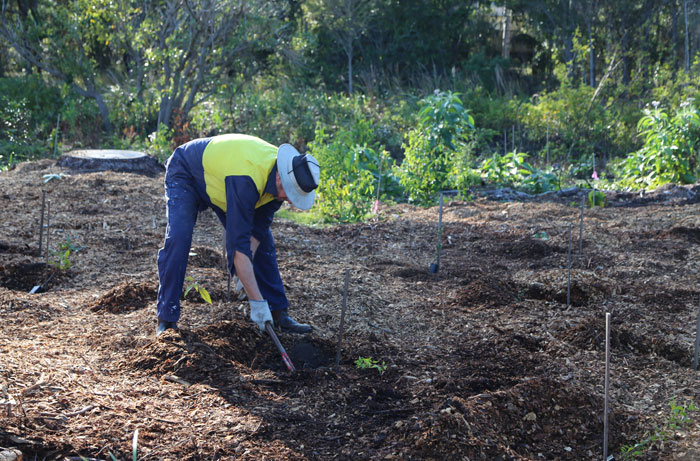
Volunteer Mick digs a hole deep enough for a tree to be planted in the middle of the regeneration patch. Pic: Trina McLellan

Spreading the mulch among the plantings was one of the tasks undertaken by volunteer Di during the August Dawn Road Reserve Bushcare working bee. Pic: Trina McLellan

After the new shrubs and edging plants were safely in place, it was time to give them some much-needed watering to settle them into their new positions. Here long-time volunteer Alison does the honours. Pic: Trina McLellan

Dawn Road Reserve Bushcare volunteer Margaret places a bamboo stake next to a freshly planted young tree. Pic: Trina McLellan
It was interesting to note that the local wildlife – possibly red-necked wallabies (Macropus rufogriseus) – have already been feasting on some of the native plants in the midst of the freshly mulched area.

Visual evidence that wildlife are finding plenty to munch on in this regeneration patch at the western edge of the Dawn Road Reserve. Pic: Trina McLellan
Where the Dawn Road Reserve’s latest revegation patch narrows, at the northern end of the site alongside Fred Campbell Drive, a second line of taller shrubs were planted.

Volunteers Michael and his dad, Gary, take care of planting along the northern end of the regeneration patch. Pic: Trina McLellan
Once the edging matrush plants were in place, it was time to position some taller plants behind them. Pic: Trina McLellan

Many hands do make light work, as these keen Dawn Road Reserve Bushcare volunteers proved in August, completing mulch spreading, edge planting and more. Pic: Trina McLellan

Looking north towards Fred Campbell Drive, you can now aoppreciate the handiwork of the Dawn Road Reserve Bushcare volunteers’ August working bee. Pic: Trina McLellan
And to mark the occasion, a special ‘souvenir’ tree was planted on the site by the Dawn Road Reserve Bushcare’s Janet Mangan. The species she chose is known as the cudgerie tree – or silver ash – (Flindersia schottiana) and it will grow to be a large tree with a dense canopy which will well and truly help fill out the view across the revegetation patch.
Where previously there had been a dense thicket of invasive broad leafed pepper and non-native radiata pines (Pinus radiata), the newly planted cudgerie and other species that have since been chosen for this site will help recreate a vista of green shrubs and trees that are more suitable for this location, which is on the western edge of one of Brisbane’s most biodiverse remaining bushland spaces and beside a usually quiet stream. However, summer downpours and flooding rains are likely to see this site inundated, so plant choice has been made with those things in mind.

Dawn Road Reserve Bushcare patron Janet Mangan carefully positions the special souvenir tree for this regeneration patch, the cudgerie – or silver ash – tree (Flindersia schottiana). Pic: Trina McLellan
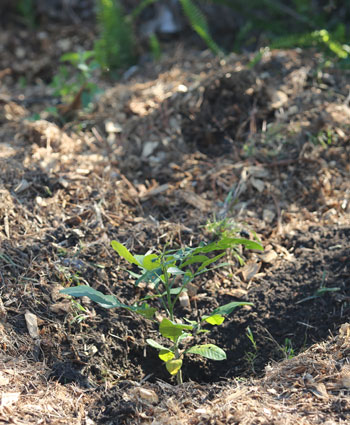
While our special souvenir specimen is quite small now, in a few years it will grow to be a large cudgerie tree (Flindersia schottiana). Also known as a silver ash, it will grow to 40m in height with a dense, rounded crown with sprays of small white flowers in early summer. Pic: Trina McLellan
July

The Dawn Road Reserve Bushcare group’s patron, Janet Mangan, takes a group of new volunteers through some of the features of the newest revegetation site. Pic: Trina McLellan
What a lovely day to be working outside, with the cool, crisp air broken only by the plentiful sounds of a range of birdlife. This month we welcomed three new volunteers, who were inducted on the Dawn Road Reserve Bushcare group’s newest revegetation zone, which sits alongside a stream and partially underneath overhead powerlines. These high-tension power lines stretch all the way from a major electrical sub-station at Brendale through a number of suburbs to the south, including Albany Creek.

This is the southern view of the powerline corridor, under which the Dawn Road Reserve Bushcare group has been working on its two revegetation project zones. The stream that runs through those zones is naturally fed by the overland flow down this rise. Pic: Trina McLellan
While the newcomers were being introduced to the site and the weeds they’d be working on, more regular volunteers were already busy thinning out identified weed species around the dozens of plants these volunteers had planted over the past six months.
Even though this zone had been thoroughly inundated, twice, in the past couple of months, preventative steps have meant almost no loss of new plantings. Simply having an upstream bamboo stake helps keep debris off the new plants and the positioning of a creek matrush (Lomandra hystrix) slightly upstream has slowed the flow of water and diverted much of the pressure that would otherwise have been exerted on the saplings and young shrubs.

It was heads down and get weeding as the Dawn Road Reserve Bushcare volunteers got to work on the newest revegetation zone. Reducing the number of weeds around recently planted beneficial species helps them establish and thrive. Pic: Trina McLellan

A new Dawn Road Reserve Bushcare volunteer works on removing billy goat weed (Ageratum houstonianum). Pic: Trina McLellan

A persistent pest species, the broad-leaf pepper (Echinus terebinthifolius) is known to come back even after it has been hit with poison. Several parent trees were removed from the newest revegetation when that project began early this year, but keeping on top of regrowth has also been important, too. Here one side of the regrowth has died back after being treated but the other is still flourishing and will require further attention. Pic: Trina McLellan

This month our newest volunteers learned about the pest species Easter cassia (Senna pendula var. glabrata), which has been a major environmental pest in this zone and presents an even greater threat to nearby bushland. Pic: Trina McLellan
Among the new plants introduced to this site was a gorgeous cordyline (one of at least 15 species of Cordyline, which are sometimes referred to as cabbage trees). And not all weed species were earmarked for immediate removal. For example, a smattering of the fast-growing wild tobacco plants (Solanum mauritianum) has been left to provide early canopy protection for slower-growing beneficial species. Once these new plants are well-established, the wild tobacco trees will be removed from the site.
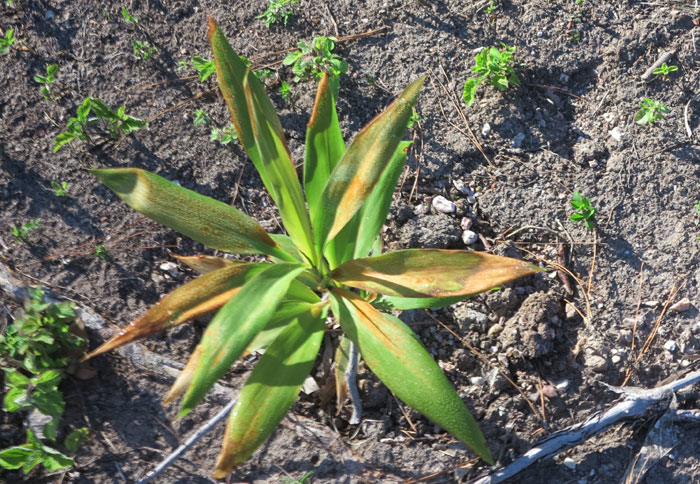
A young cordyline (one of about 15 different species within the Cordyline genus) – which is related to both lomandra and asparagus – establishes itself in the Dawn Road Reserve Bushcare group’s newest revegetation patch. Pic: Trina McLellan

Early morning dew glistens on the leaves of this wild tobacco (Solanum mauritianum), which is currently in flower. Pic: Trina McLellan
As in recent months, the Dawn Road Reserve Bushcare volunteers were treated to visits by a few different bird species, including a juvenile and adult Australian magpie (Cracticus tibicen), rainbow lorikeets (Trichoglossus moluccanus), pied butcherbirds (Cracticus nigrogularis) and the rather naughty noisy miners (Manorina melanocephala), which like to chase away other bird species, even much larger avian cousins.

A juvenile magpie (Cracticus tibicen) feeds on some tasty morsel along the grassy edge of the newest revegetation zone. Pic: Trina McLellan

The juvenile magpie also fossicked among the pine tree mulch in the newest revegetation zone. Pic: Trina McLellan

Nearby an adult magpie, most likely a parent to the juvenile, kept a weather eye on the youngster, any tasty morsels and on this photographer. Pic: Trina McLellan
![[FILE PHOTO] Rainbow lorikeets (Trichoglossus haematodus) are a common sight in and around the Dawn Road Reserve](https://naturewatchalbanycreek.files.wordpress.com/2016/03/tmcl-lorikeet-grevillea1.jpg?w=700&h=528)
[FILE PHOTO] Rainbow lorikeets (Trichoglossus haematodus) are a common sight in and around the Dawn Road Reserve. Pic: Trina McLellan
June

It was wonderful to see the new growth on the shrubs and saplings along the southern border of the Dawn Road Reserve’s original regeneration patch. But it’s time for the weeds to be pulled and the tree guards to come off! Pic: Trina McLellan
So now the cool weather has finally arrived, it is time to review recent growth on our original revegetation patch. The southern boundary zone has gone ahead leaps and bounds, so much so that it was past time to remove the tree guards originally positioned to keep hungry wildlife from nibbling on young leaves and branches.
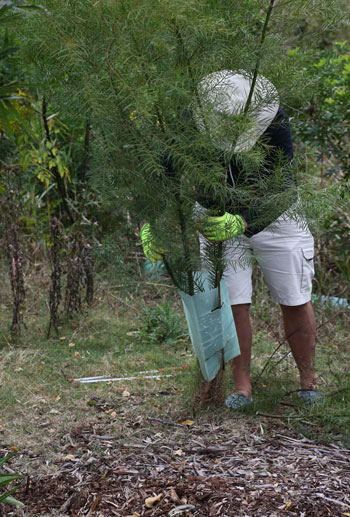
Before the tree guards could be removed, some lower limbs had to be lopped and upper limbs contained. Pic: Trina McLellan

Then the task of gently raising the guard over the compressed limbs could begin. Pic: Trina McLellan

It helps if you’re tall! Visiting volunteer Christian Perrin carefully removes the guard with minimal disruption to this healthy plant. Pic: Trina McLellan
We were blessed in June with two loftier visitors, with Wild BNE‘s Christian Perrin and Aspley resident Aaron Wiggan joining our small group to help with working bee tasks. With the new growth exceeding 2m in some cases, their extra height was put to good use.

With some tree guards, it took two willing hands to slide off the green Corflute triangles. Pic: Trina McLellan

Removal of this tree guard required plenty of height and quite a bit of determination, but it eventually slid off. Pic: Trina McLellan
But the end result was just fine, with all shrubs and young trees liberated from their protective guards and only one shrub lost during the recent downpour which scoured a path through the planting.

Dawn Road Reserve Bushcare volunteer removes a tree guard from one of the smaller shrubs with relative ease, while a recent downpour caused the downing of one of the plants as water raced downhill through this planting. Pic: Trina McLellan

This is the path that the overland flow took during the recent downpour – right through our hillside planting. Thankfully only one plant was lost. Pic: Trina McLellan
But tidying up this hillside planting was not the extent of the work done this month. Nearby, alongside the stream in the original revegetation patch, it was great to see that native grasses and sedges had moved in to keep the young beneficial plants company.

Look closely and you can see several pink tags marking the beneficial plants introduced to the original revegetation zone. Native grasses and sedges have now moved in to keep them company. Pic: Trina McLellan

It might be a bit easier to see the pink tags marking the beneficial plants in this image. Pic: Trina McLellan
Finally, the volunteers moved on to the newest revegetation patch and began removing a number of weed species, including some young wild tobacco trees (Solanum mauritianum), while noting the healthy growth of the dozens of beneficial plants that had been introduced earlier this year. And there were a few nice surprises when the volunteers were working on this zone, including the spectacularly coloured hibiscus harlequin bug (Tectocoris diophthalmus), a pair of Australian wood ducks (Chenonetta jubata) and a laughing kookaburra (Dacelo) intently stalking its prey.

In the newer revegetation patch, the weed species wild tobacco (Solanum mauritianum) has sprung up, but was selectively removed by Dawn Road Reserve Bushcare volunteers. Some of these fast-growing specimens will be allowed to stay temporarily and provide an early canopy for other slower-growing, beneficial plants. Once those are established, the remaining wild tobacco plants will be removed. Pic: Trina McLellan

In the second revegetation patch, while the weeds have sprung up and are being controlled, the beneficial plantings (those marked with bamboo stakes) are progressing well and will soon be dominating the landscape. Pic: Trina McLellan

Dawn Road Reserve Bushcare volunteers removed the bulk of ripe red berries of the Brazilian nightshade (Solanum seaforthianum) that were evident on the original regeneration patch. Pic: Trina McLellan

The volunteers had to look carefully into the undergrowth to locate some of the ripe red berries of the Brazilian nightshade (Solanum seaforthianum). Pic: Trina McLellan

When volunteers were trimming back overgrowth of a weed hibiscus thicket along one edge of the new revegetation zone, this magnificently coloured hibiscus harlequin bug (Tectocoris diophthalmus) emerged. Pic: Trina McLellan

As Dawn Road Reserve Bushcare volunteers worked on the newer revegetation patch, a keen-eyed kookaburra (Dacelo) was perched overhead, intently checking out the dining options below. Pic: Trina McLellan

While enjoying a cuppa after the working bee, the Dawn Road Reserve Bushcare volunteers were treated to a visit on a neighbouring lawn of two Australian wood ducks (Chenonetta jubata). Pic: Trina McLellan
But the really unexpected discovery of the morning was the ‘tok, tok’ call of the striped marsh frog (Limnodynastes peronii), specimens of which had inhabited a small rainwater catchment that separates the two revegetation sites.
LISTEN: To a 2-minute interview with Wild BNE‘s Christian Perrin about this frog and listen carefully to hear its distinctive call. And to read all about
UPDATE: To read about the nature walk, pop over to Christian’s blog post.
May

When the Dawn Road Reserve Bushcare group arrived on a crisp May morning, the mountain of woodchip awaiting spreading was so warm that it was steaming. Pic: Trina McLellan
At last, after an elongated, humid summer, the worst of the warm weather is behind us, however there has been very little rainfall over the Dawn Road Reserve Bushcare group’s second revegetation site, yet that does not seem to have deterred new growth of both beneficial plants and weed species.
So the volunteers got down to work after admiring the steaming pile of woodchips that will need to be spread soon to define a mowing edge for this space that sits alongside an easement that fronts several homes.

All hands to the tools as the Dawn Road Reserve Bushcare volunteers work on the second revegetation area. Pic: Trina McLellan
With the shortage of water from the heavens over recent weeks, volunteers found there was plenty of groundwork and watering to be done to help new plants get established.
And, in some places, the ground was too dry and hard to simply pull out invasive weeds, so a pick axe had to be brought into service.

At the new revegetation site, which has had little rain over the past weeks, some of the groundwork preparation ahead of planting requires some careful pick axe work. Pic: Trina McLellan

Hand watering of new plants in the Dawn Road Reserve Bushcare’s second revegetation zone is part of the work volunteers complete during monthly working bees. Pic: Trina McLellan
The great news is the diversity of beneficial species is starting to become apparent, with locally endemic soap tree (Alphitonia excelsa), cheese tree (Glochidion ferdinandi), the magnificent rainforest species, the firewheel tree (Stenocarpus sinuartus), and the poison peach (Trema tormentosa) all establishing healthy specimens.

This fast-growing soap tree (Alphitonia excelsa) is endemic to the local bushland and now growing on our second revegetation site. Pic: Trina McLellan

This young cheese tree (Glochidion ferdinandi) was looking healthy in the Dawn Road Reserve Bushcare group’s second revegetation site. Pic: Trina McLellan

A part of the protea plant species, this forest firewheel tree (Stenocarpus sinuartu) will grow up to flower with a magnificent show of red blooms. Pic: Trina McLellan
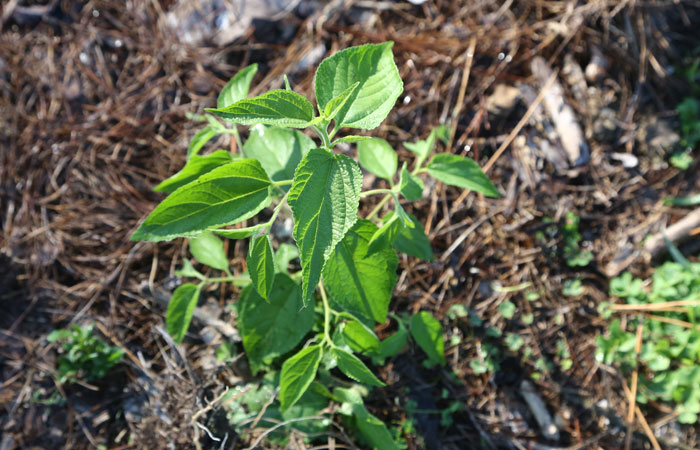
A young poison peach (Trema tormentosa) is among the beneficial plants establishing on the second revegetation site. Pic: Trina McLellan

Even though there are plenty of weed species and grasses springing up on the recently cleared second revegetation site, a determined beneficial native plant, this young poison peach (Trema tormentosa), is already staking its claim. Pic: Trina McLellan
As ever, though, the battle against several invasive weed species goes on across the newest revegetation zone, with interlopers determined to set up house on the recently cleared ground.
The most persistent of them all is the broad-leaf pepper tree (Schinus terebinthifolius), which was initially cleared from the site and, while it’s branches and trunks were chipped for recycling, its stumps and its below-ground runners are still shooting up new growth that needs to be poisoned before that new growth throws seed-bearing fruits that can be spread by birds and small animals.

This is how quickly the broad-leaf pepper re-establishes itself and why it’s in our sights. Pic: Trina McLellan

A dense thicket of the persistently invasive species known as the broad-leaf pepper tree (Schinus terebinthifolius) was cleared ahead of this second revegetation project. Since then any regrowth has been drilled and dosed with a specific poison by the group’s trained patron, Janet Mangan. Pic: Trina McLellan
Then there were spots of climbing asparagus fern (Asparagus africanus), Easter cassia (Senna pendula var. glabrata), balloon cottonbush (Gomphocarpus physocarpus) and Brazilian nightshade (Solanum seaforthianum).

Dotted around the second revegetation site are signs of another invasive species, the climbing asparagus fern (Asparagus africanus), whose crowns were pulled carefully by hand and removed from site. Pic: Trina McLellan

Our old nemesis, the easter cassia (Senna pendula var. glabrata), is still easy to spot with its bright yellow blooms. A thicket of these trees are being treated alongside the revegetation site but in the meantime, volunteers will continue to remove any offspring that come up. Pic: Trina McLellan

Yet again, the invasive ballon cottonbush (Gomphocarpus physocarpus) needed to be removed from the second revegetation site. Pic: Trina McLellan

Another familiar plant from our earlier revegetation site is now cropping up on the new site. It is Brazilian nightshade (Solanum seaforthianum), which thankfully simply needs pulling out before it gets too established. Pic: Trina McLellan
But the biggest buzz this month was the visiting birdlife, with a pair of galahs (known either as Eolophus roseicapillus or Cacatua roseicapillus) who were perched on one of the remaining pine trees, happily watching over the volunteers as they worked. You can read more about them here.

This curious pair of galahs were perched on a short branch of a pine tree, watching over the volunteers. Pic: Trina McLellan
Then an eagle-eyed visiting volunteer, Christian Perrin – of Wild BNE fame – noticed a tawny frogmouth (Podargus strigoides) asleep in the crook of a nearby tree.

Can you see the tawny frogmouth (Podargus strigoides) camouflaged in the crook of this tree? Pic: Trina McLellan
And, finally, just before the working bee concluded, we were graced with the solo cacophony generated by a lone sulphur-crested cockatoo (Cacatua galerita) that passed overhead while calling to all of its mates who might have been lurking in the district.

A noisy but graceful sulphur-crested cockatoo (Cacatua galerita) passes overhead. Pic: Trina McLellan
April

Check out the progress on the dozens of plants introduced to the southern-most section of the Dawn Road Reserve’s original regeneration patch. Pic: Trina McLellan

The view from the western edge of our southern-most planting in the original Dawn Road Reserve regeneration patch. Pic: Trina McLellan

LEFT: Check out the diversity of plants in the southern section of the original regeneration project. Pic: Trina McLellan
RIGHT: Hale and hearty, this young bush is heading skywards at great knots. Soon it won’t need its protective collar. Pic: Trina McLellan
After reviewing the magnificent growth of the southern edge of the original regeneration patch that the Dawn Road Reserve Bushcare volunteers have worked on for more than a year, this month’s working bee got an early start on our latest regeneration project area, removing some of the invasive weeds that had taken advantage of the recently cleared zone.

Dawn Road Reserve Bushcare group’s patron, Janet Mangan, stands among the burgeoning spread of balloon cotton bush (Gomphocarpus physocarpus), which was then tamed by hand pulling. Pic: Trina McLellan
Thankfully, some were quite easily pulled by hand and left to rot, including quite a bit of newly sprouted balloon cotton bush (Gomphocarpus physocarpus), held aloft here by our patron, Janet Mangan. This milkweed species is quite prevalent in this neck of the reserve. This may explain why you often can see plenty of Monarch (or wanderer) butterflies (Danaus plexippus), which love to feed on this pest plant.

While this invasive weed, the balloon cotton bush (Gomphocarpus physocarpus) is already rampant and requiring removal in our latest regeration patch, the Monarch butterflies (Danaus plexippus) love it. Pic: Trina McLellan
One eagle-eyed volunteer even found a distinctively marked caterpillar which will soon turn into another Monarch butterfly.

In a short while, this caterpillar is destined to become a Monarch butterfly (Danaus plexippus). These butterflies are quite common around the edges of the Dawn Road Reserve. Pic: Trina McLellan
And, it being Easter time, the bright yellow blooms of the Easter cassia (Senna pendula var. glabrata) were evident everywhere, including in a dense thicket to the east of our latest regeneration zone.

To give you some idea of how rampant the Easter Cassia (Senna pendula var. glabrata) is, here the Dawn Road Reserve Bushcare patron Janet Mangan is standing next to a small section that abuts our new revegetation patch. Pic: Trina McLellan

More of the invasive Easter cassia (Senna pendula var. glabrata), which is in full flower around this time of the year. Despite its bright yellow flowers, it is an easily spread pest species that requires constant monitoring and attention. Pic: Trina McLellan
But not all the new growth in the recently cleared zone itself involved unwanted species. This hardy native sedge was establishing itself among other less favoured weeds.

This native sedge has popped up on the newest regeneration site, a positive sign that the recently cleared area is ready to sustain native plants. Pic: Trina McLellan
After 8am, the busy group of volunteers trekked into the reserve itself to a lovely creekside spot known locally as Dingley Dell, where concerns had been raised about a growing number of weed species invading what is an ecologically diverse riparian zone that is slowly evolving into a rainforest zone.

The lovely Dingley Dell area has a wonderful diversity of plants at all levels and is dappled with light throughout the day, thanks to the denser canopy overhead and a nearby creek. Pic: Trina McLellan

The sun peeps through the canopy at Dingley Dell, giving enough light to encourage plentiful growth in this part of the Dawn Road Reserve. Pic: Trina McLellan

After arriving at the entrance to Dingley Dell, a group of Dawn Road Reserve Bushcare volunteers discuss the best plan of action. Pic: Trina McLellan

Dawn Road Reserve volunteers get to work at Dingley Dell under the watchful eye of MBRC’s Bushcare officer Wendy Heath. Pic: Trina McLellan
In Dingley Dell, the main concerns were the widespread appearance of Mickey Mouse plant (Ochna serrulata), an ornamental exotic that has escaped from local gardens and is proving a real menace in woodland areas, and the coral berry (Ardisia crenata). Both have red berries that are extremely attractive to birds and other wildlife, so their seeds are easily spread. And removing Ochna is no easy task, but if left to its own devices – or removed incorrectly or by fire – it will thrive and regenerate, often with up to five times the original shoots.

Because they have tap roots that bend to hold on tight to the soil, removing even small Mickey Mouse plants (Ochna serrulata), requires plenty of bending, careful surface scraping near the base and then quickly painting on an appropriate poison to ensure the plant does not regenerate. Pic: Trina McLellan

A clump of coral berry (Ardisia crenata), an exotic weed that is an established pest species in shadier areas of the Dawn Road Reserve. Pic: Trina McLellan

Having identified a thicket of coral berry (Ardisia crenata), volunteers set to work, firstly removing its berries and taking them off-site so the plant – which is then removed by hand – does not spread any further because the berries remain viable even if the plant dies. Pic: Trina McLellan
While the group was working hard at Dingley Dell, it was time to duck down the track to see if our small koala was still residing in a nearby tree. And, lo and behold, she’s still there. However, as you can see from this picture, she seems to have a discoloured rear end and that could indicate that she is unwell. So a local koala group has been notified and will soon check on her welfare.
If you do happen to be koala-spotting in the reserve, here are the kinds of trees to look around for (thanks to the Queensland Parks and Wildlife Service).

Our little friend is still up her regular tree in the reserve, although we are a little concerned about her health. Authorities have been notified. Pic: Trina McLellan
March
While steamy, overcast conditions deterred some Dawn Road Reserve Bushcare volunteers, others were more than willing to pitch in on the new revegetation site, which now has dozens of new plants to replace the dense, overgrown and weedy species that were removed earlier this year.

Some of the Dawn Road Reserve Bushcare group, whose new revegetation project has been funded by the Moreton Bay Regional Council’s Community Grants Program. Pic: Trina McLellan
One of the side benefits of the clearing of pest species is that the broad leaf peppers and radiata pine trees provided plenty of woodchips that will be spread around the revegation areas to help define mowing edges and protect young plants from being overrun by weeds.

Just two of several sizeable piles of woodchips left on the Dawn Road Reserve that will be used across the revegetation areas. Pic: Trina McLellan
Two of the replanted species in the new revegetation site this month were the water-tolerant Bblack tea tree (Melaleuca bracteata), a medium-sized screening plant with fine, scented foliage and profuse, white, brush-like flowers that appear in all seasons except autumn, and the tall native wetland tree known as the weeping lilly pilly (Waterhousea floribunda). These should fare well because the stream that flows through the area is prone to overflowing its banks during a downpour.

This weeping lilly pilly (Waterhousea floribunda) will be right at home alongside the stream that flows through the revegetation site. Pic: Trina McLellan

With its fine, scented foliage and profuse flowers for most of the year, this black tea tree (Melaleuca bracteata) will also be right at home alongside the stream that runs through the revegetation site. Pic: Trina McLellan
While the footprint of such occasional ‘flooding’ is restricted to a few metres either side of the stream – occurring well within the site itself – this means young and small plants need to receive extra protection until they are well established.
Replanting at this second revegetation site follows much the same pattern as before, with volunteers digging appropriate sized holes, placing the new plants and some fertiliser in those holes before back-filling and tamping down the soil to give the newcomer a firm start in its new home.

At the planting stage, Dawn Road Reserve Bushcare’s Janet Mangan demonstrates how to prepare the ground and plant appropriate species for the newest revegetation site. Pic: Trina McLellan

Once the plant and some fertiliser are in place, Dawn Road Bushcare volunteer Kerry backfills the soil around the base of the sapling she has planted. Pic: Trina McLellan
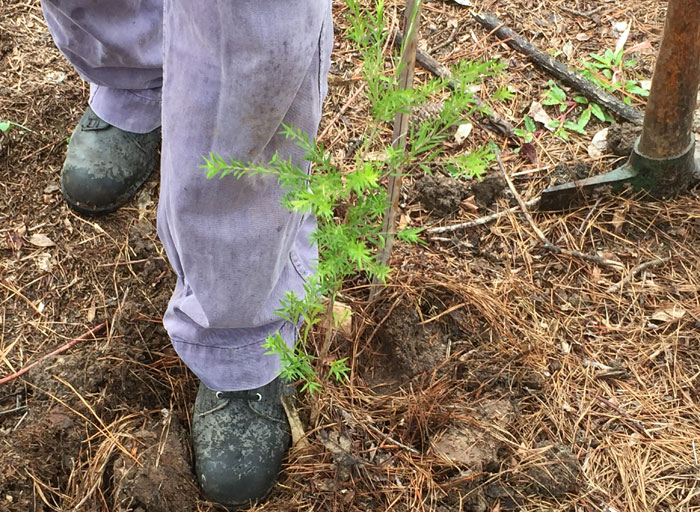
After Dawn Road Reserve Bushcare volunteer Gary had finished positioning his new sapling, he carefully tamped the soil down to reduce air pockets around its roots. Pic: Trina McLellan
One interesting development, however, has been the clever addition of a couple of downstream grassy plants – Lomandra hystrix (also known as creek mat rush) in this case – which have been positioned to slow or at least deflect any floodwaters that might otherwise carry away the young saplings.

Dawn Road Reserve Bushcare volunteer Michael ensures an important buffer of Lomandra hystrix is placed downstream of a newly planted and still delicate beneficial native species. Pic: Trina McLellan

Placing the Lomandra hystrix downstream of a young plant will help protect it from any floodwaters that might sweep through the revegetation patch, which is located alongside a small stream in the Dawn Road Reserve. Pic: Trina McLellan

Once the new plants are in place, an empty seedling case is upturned on a stake to indicate the new plant is yet to be watered. Pic: Trina McLellan

TOP LEFT: Dawn Road Bushcare volunteer Alison ensuring the new plants are well-watered. (Our special thanks to nearby neighbour Sue Campbell for the generous use of her tap water to top up the water containers.)
BOTTOM LEFT: A label from the mat-rush (Lomandra hystrix) that will protect the new plantings until they are well established.
RIGHT: One of the revegetation plantings was this sandpaper fig (Ficus coronata), a pioneer species that grows quickly and provides stream bank stabilisation. Pix: Trina McLellan
Over the past two working bees, Dawn Road Reserve Bushcare volunteers have planted more than 50 beneficial trees and shrubs on the group’s second revegetation site, with care taken to ensure positioning and aftercare are sensitive to the adjacent powerlines and nearby residential properties.
Replacing invasive pest species with appropriate native species will not only mean a more suitable plant profile for this patch in the long term, but it will also attract and sustain more beneficial insects and native animals.
Fingers crossed our two adjacent revegetation sites continue to get sufficient gentle rainfall over the coming months to negate the need to hand water!
As Dawn Road Reserve Bushcare volunteers again discovered this month, working bees can turn up some interesting finds. Eagle-eyed patron Janet Mangan pointed out tiny native bees congregating in and around a notch in a small tree.
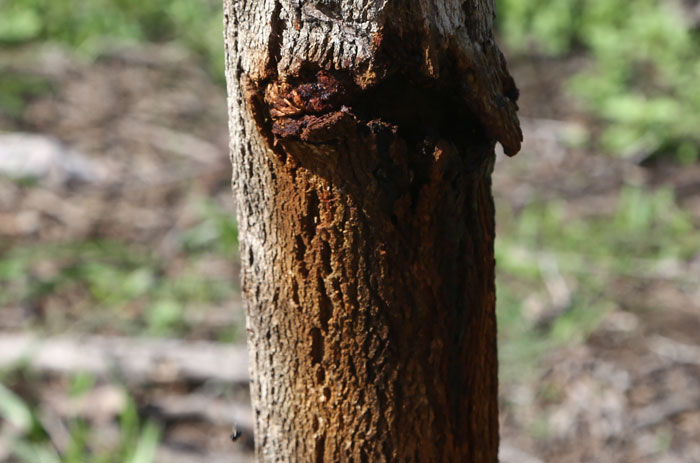
Look very carefully and you might just see a tiny native bee heading for this protective notch in a small tree at the southern end of the new revegetation site. Pic: Trina McLellan
Nearby, there is a filtration pond that keeps larger debris from entering the sensitive waterway that runs through our revegetation sites. Now well-established, the pond attracts a number of different frog species and dragonflies.

Because stormwater and domestic runoff head down towards the stream running through the revegetation sites, this filtration pond helps keep larger debris from fouling the waterway. Pic: Trina McLellan
And already a tropical rainforest creeper, Stephania japonica – or snake vine – has arisen among the leaf litter left behind on the Dawn Road Reserve’s newest revegation site.

The beneficial native vine Stephania japonica – or snake vine – has already begun to thrive on the new revegetation patch. Pic: Trina McLellan

Again, a little hard to see against gloves of a similar colour, but this tiny cane toad (Bufo marinus), a poisonous creature native to Central and South America, is a dreadful pest species introduced to Australia in 1935 to control beetles in cane crops. Pic: Trina McLellan
However, not all of the ‘finds’ were beneficial to the new revegetation site or to the district.
According to long-time locals, this year seems to have been a boomer for cane toads (Bufo marinus).
And on the day of the March working bee, there were hundreds of tiny toads scattering about the site as we worked.
On its website, the Australian Government’s Department of the Environment says: “The cane toad defends itself through poison and is poisonous, to varying degrees, during all its life stages. Adult cane toads produce toxin from glands over their upper surface, but especially from bulging glands on their shoulders — these exude venom when the toad is provoked. While some birds and native predators have learned to avoid the poison glands of adult toads, other predators are more vulnerable and die rapidly after ingesting toads. Toads contain poisons that act on the heart and on the central nervous system. The poison is absorbed through body tissues such as those of the eyes, mouth and nose.”
Very few native animals or birds have learned to adapt to the dangers presented by cane toads, so the toll on wildlife can be enormous where these invaders flourish.
Other invasive species catching the attention of the Dawn Road Reserve Bushcare volunteers this month were the pervasive balloon cotton bush (Gomphocarpus physocarpus) and another opportunistic shrub, the dark blue snakeweed (Stachytarpheta cayennensis).
Both of these weeds, left to their own devices, are quick-spreading, so volunteers have begun the process of removing them from the site and will continue to monitor their presence in the coming months.

This dark blue snakeweed (Stachytarpheta cayennensis) is a long-lived invasive exotic species that originally comes from Central America but is an environmental weed here in South-East Queensland. Pic: Trina McLellan
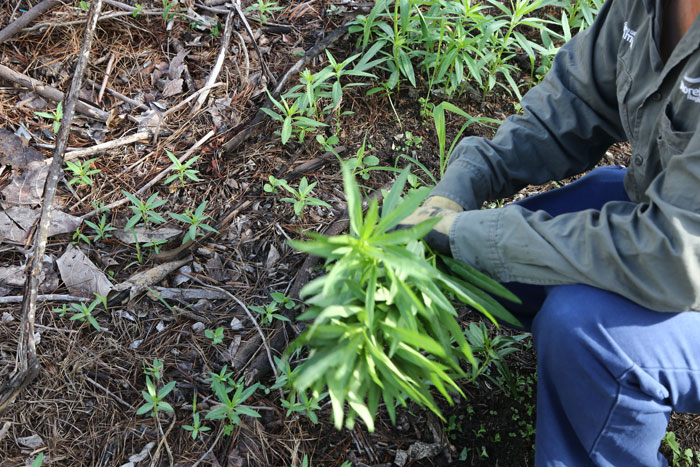
Another environmental weed on this revegetation site is balloon cotton bush (Gomphocarpus physocarpus), which grows up to 2m tall, can flower – with balloon-like fruit measuring 5-7.5cm in length – all year round. Pic: Trina McLellan

It was also great to see the continued progress of dozens of plants positioned at the southern end of the original revegetation site that the Dawn Road Reserve Bushcare group worked on in 2015. Pic: Trina McLellan
February
Some exciting news before reporting back about our first working bee for 2016. After extensive community consultation and a fresh application for extended funding, led by our Dawn Road Bushcare patron Janet Mangan, a bid to extend our revegetation zone to the north was approved late in 2015.

This is what the new revegetation patch looked like at the beginning of the year: tall pines and thick undergrowth species, all non-native, invasive trees that threatened to spread into neighbouring bushland areas. Pic: Trina McLellan
In early February, some necessary clearance work – involving the removal of invasive pest species broad leaf pepper (Schinus terebinthifolius) and Easter cassia (Senna pendula var. glabrata) as well as the thinning out of misplaced radiata pines (Pinus radiata), which are an escaped plantation species that become unwelcome weeds in natural areas – was done by contractors, allowing the Dawn Road Bushcare Group to begin work on the new revegetation area at our very first 2016 working bee.
While the understory was cleared out, you might wonder why only some of the taller cone-bearing pines were removed and others left in place, given the propensity for relatively easy propagation.
After consulting with local residents, it was decided that – if all of the pines were removed at once – it would also remove the visual barrier that had grown up between the houses and the overhead high-voltage power lines that overpass the site.

Looking into the new revegetation patch early in January, you could see the selected pines marked for removal as well as how dense the broad leaf peppers that had populated the understory. Between these two species, they had choked out any species native to this area. Pic: Trina McLellan
Over the next few years, until the newer native species trees and shrubs grow up, fill out and provide their own dense canopy visual barrier, the remaining pines will help do that work and the Bushcare team will remove any new pines that pop up.

Just how barren the area around the base of a pine tree can be. Note the falling cones can also see new plants establishing with ease and the seeds can be carried into nearby bushland. Pic: Trina McLellan
The presence of these power lines made even selective removal of the largest pines a somewhat tricky prospect, so the contractors are to be congratulated for downing them responsibly and chipping them onsite without incident, leaving plenty of mulch for working bees to work with over the coming months.

Even at the edge of the earmarked new revegetation patch, you can see how nothing much will grow directly underneath a pine tree, not even grass. Pic: Trina McLellan

To give you some idea of how dense the undergrowth broad leaf peppers were in this patch, here are the remnants of their trunks. Pic: Trina McLellan
So the very first Dawn Road Bushcare Group working bee got under way in mid-February, with many hands making headway with new plantings.

Despite the heat, the February Dawn Road Bushcare Group got down to work with lots of enthusiasm. Pic: Trina McLellan
We welcomed back some familiar faces as well as a couple of new volunteers as the task of replanting in the cleared zone got under way.

A selection of fast-growing native trees and understory shrubs awaited planting in the Dawn Road Reserve’s new revegetation patch. Pic: Trina McLellan

A selection of healthy, new, native plants was brought on site to replenish the new patch. Pic: Trina McLellan

Preparing the recently cleared ground was hard work in places, especially where there were heavier clay soils that hadn’t absorbed enough moisture, but new Dawn Road Reserve volunteer Mike was undaunted. Pic: Trina McLellan

In the process of replacing understory species, as new volunteer Di discovered, it is critical to not only place the right species, but to also fertilise and water the new plants in place. Pic: Trina McLellan

Regular volunteers Harper and his mum, Teal, take extra care replanting at the revegetation site. Pic: Trina McLellan

After tackling the heavier clay soil, longtime volunteer Gary replants one of the faster-growing tree species that will help provide a visual barrier into the future. Pic: Trina McLellan

One common ground weed in this area is the asparagus fern (Asparagus aethiopicus) and the Dawn Road Reserve Bushcare team have learned how to remove it. Pic: Trina McLellan

Nothing wasted! The chipped pest trees will provide useful mulch for the Dawn Road Reserve Bushcare activities over the coming months. Pic: Trina McLellan
There will be lots to do over the coming months and we’re hoping that gentle rain might soften some of the heavier soils, but a great start has already been made on this new revegetation patch.

The southern edge border planting in the Dawn Road Reserve’s revegetation project is coming along nicely after a good dose of summer weather. Pic: Trina McLellan
Welcome back to this special community project for 2016. Over the summer break in January, we had some lovely rain to go with the warm weather, which helped new growth on many of our 2015 plantings.
Perhaps the easiest to see in this regard is the southern edge planting, which was populated with 20+ shrub species and mulched carefully to create a clear mowing boundary for council contractors.
Just look at how those shrubs are thriving. Soon we’ll be able to remove their protective guards because they will be fully established.

Some of the new shrubs at the southern edge of the revegetation project are now almost high enough to do without their protective covers. Pic: Trina McLellan

Without protective coverings, these shrubs could not have advanced so far over the summer because they would have been juicy pickings, especially for our nocturnal wallaby visitors. Now they are almost ready to withstand any such visitors. Pic: Trina McLellan
Sources:
Weeds of Australia (a State Government resource)
Weeds in Australia (a Federal Government resource)






